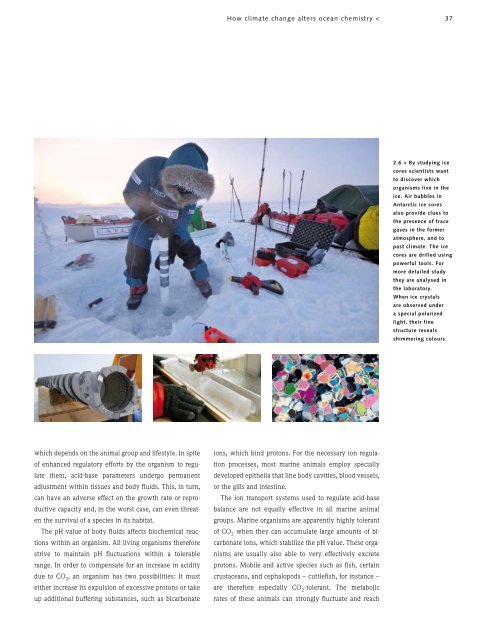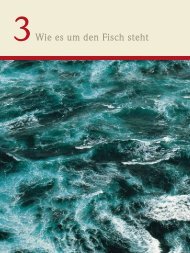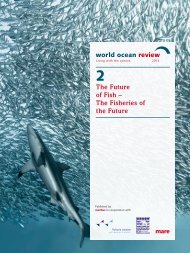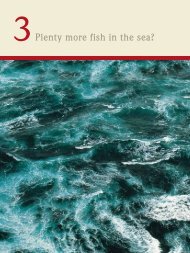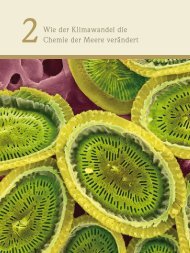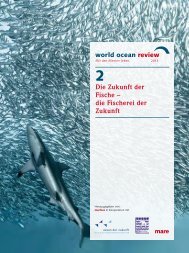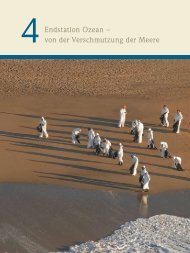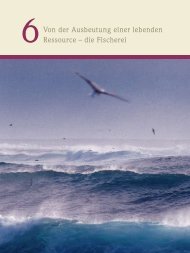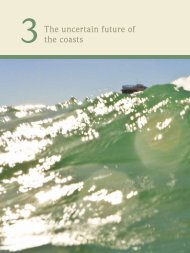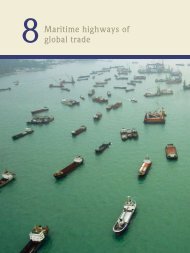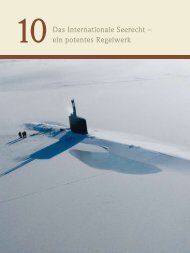- Page 1 and 2: World Ocean Review
- Page 3: Living with the oceans.world ocean
- Page 6 and 7: 4> world ocean reviewPrefaceOur env
- Page 8 and 9: 6> world ocean reviewPreface 4The w
- Page 10 and 11: 1The world oceans, globalclimate dr
- Page 12 and 13: 10> Chapter 01Earth’s climate sys
- Page 14 and 15: 12> Chapter 01The difficulty of det
- Page 16 and 17: 14> Chapter 01Magnitude of response
- Page 18 and 19: 16> Chapter 01The great ocean curre
- Page 20 and 21: 18> Chapter 01most important factor
- Page 22 and 23: 20> Chapter 01The Coriolis forceThe
- Page 24 and 25: 22> Chapter 0112080Watts per square
- Page 26 and 27: 24> Chapter 011.13 > As a rule,iceb
- Page 28 and 29: 26> Chapter 022How climate change a
- Page 30 and 31: 28> Chapter 02The oceans - the larg
- Page 32 and 33: 30> Chapter 02Fertilizing the ocean
- Page 34 and 35: 32> Chapter 02human-made atmospheri
- Page 36 and 37: 34> Chapter 02Our present picture i
- Page 40 and 41: 38> Chapter 02When carbonate format
- Page 42 and 43: 40> Chapter 02very high levels duri
- Page 44 and 45: 42> Chapter 022.11 > The clownfish
- Page 46 and 47: 44> Chapter 02Oxygen in the ocean>
- Page 48 and 49: 46> Chapter 02Oxygen concentration
- Page 50 and 51: 48> Chapter 02Climate change impact
- Page 52 and 53: 50> Chapter 02Depthin metres5001000
- Page 54 and 55: 52> Chapter 022.20 > Large quantiti
- Page 56 and 57: 54> Chapter 033The uncertain future
- Page 58 and 59: 56> Chapter 03Sea-level rise - an u
- Page 60 and 61: 58> Chapter 033.3 > Tourists prepar
- Page 62 and 63: 60> Chapter 03How nature and humank
- Page 64 and 65: 62> Chapter 033.7 > The oldlighthou
- Page 66 and 67: 64> Chapter 033.9 > At times ofespe
- Page 68 and 69: 66> Chapter 03High tide andspring t
- Page 70 and 71: 68> Chapter 03The battle for the co
- Page 72 and 73: 70> Chapter 033.14 > The Netherland
- Page 74 and 75: 72> Chapter 03Top ten nations class
- Page 76 and 77: 74> Chapter 044Last stop: The ocean
- Page 78 and 79: 76> Chapter 04Over-fertilization of
- Page 80 and 81: 78> Chapter 044.3 > When conditions
- Page 82 and 83: Dt80> Chapter 04The Mississippi Riv
- Page 84 and 85: 82> Chapter 04Organic pollutants in
- Page 86 and 87: 84> Chapter 044.8 > PFOS concentrat
- Page 88 and 89:
86> Chapter 04Litter - pervading th
- Page 90 and 91:
88> Chapter 04fish, turtles, dolphi
- Page 92 and 93:
90> Chapter 044.12 > The Laysan alb
- Page 94 and 95:
92> Chapter 04Oil pollution of mari
- Page 96 and 97:
94> Chapter 04How oil damages habit
- Page 98 and 99:
96> Chapter 044.10 Oiled > Ölversc
- Page 100 and 101:
98> Chapter 044.18 > Workers on abe
- Page 102 and 103:
5Climate change impacts onmarine ec
- Page 104 and 105:
102> Chapter 05Biological systems u
- Page 106 and 107:
104> Chapter 05die out in their nat
- Page 108 and 109:
106> Chapter 05Disruption to the pl
- Page 110 and 111:
108> Chapter 05The CO 2pump in the
- Page 112 and 113:
110> Chapter 05Species encroaching
- Page 114 and 115:
112> Chapter 05Iberian Atlantic Coa
- Page 116 and 117:
114> Chapter 05Marine biodiversity
- Page 118 and 119:
116> Chapter 05blades of seagrass i
- Page 120 and 121:
6Exploiting a living resource:Fishe
- Page 122 and 123:
120> Chapter 06Marine fisheries - t
- Page 124 and 125:
122> Chapter 0616142007121086420Mil
- Page 126 and 127:
124> Chapter 06The fate of the codA
- Page 128 and 129:
126> Chapter 06The causes of overfi
- Page 130 and 131:
6.11 > Even today, deep-sea fishing
- Page 132 and 133:
130> Chapter 06Classic approaches t
- Page 134 and 135:
132> Chapter 06A negative example -
- Page 136 and 137:
134> Chapter 06Fishing gear How it
- Page 138 and 139:
136> Chapter 06Toward more sustaina
- Page 140 and 141:
138> Chapter 066.17 > Cod is common
- Page 142 and 143:
Chapter 077Marine mineralsand energ
- Page 144 and 145:
142 > Chapter 07Fossil fuels> Oil a
- Page 146 and 147:
144 > Chapter 07OnshoreOffshoreTota
- Page 148 and 149:
146 > Chapter 07Marine minerals> Na
- Page 150 and 151:
148 > Chapter 072006 Germany also s
- Page 152 and 153:
150 > Chapter 07aa1000e2000Manganes
- Page 154 and 155:
152 > Chapter 07Methane hydrates> U
- Page 156 and 157:
154 > Chapter 07Gas moleculesWater
- Page 158 and 159:
156 > Chapter 07Renewable energies>
- Page 160 and 161:
158 > Chapter 07Rance River flows i
- Page 162 and 163:
160 > Chapter 077.13 > Wind turbine
- Page 164 and 165:
8Maritime highways ofglobal trade
- Page 166 and 167:
164> Chapter 08Global shipping - a
- Page 168 and 169:
166> Chapter 08In the past, the lib
- Page 170 and 171:
168> Chapter 08General cargo shipOi
- Page 172 and 173:
170> Chapter 08transported by sea.
- Page 174 and 175:
172> Chapter 08Obstacles to global
- Page 176 and 177:
174> Chapter 088.7 > For fear of pi
- Page 178 and 179:
9Medical knowledgefrom the sea
- Page 180 and 181:
178> Chapter 09Active substances fr
- Page 182 and 183:
180> Chapter 099.3 > Many effective
- Page 184 and 185:
182> Chapter 09Isolated substance C
- Page 186 and 187:
184> Chapter 09The fight against an
- Page 188 and 189:
186> Chapter 09Searching for the ca
- Page 190 and 191:
188> Chapter 09More than the sum of
- Page 192 and 193:
190> Chapter 09Legal issues in mari
- Page 194 and 195:
192> Chapter 099.15 > Regulationof
- Page 196 and 197:
194> Chapter 099.17 > Heat-loving,
- Page 198 and 199:
10The law of the sea:A powerful ins
- Page 200 and 201:
198> Chapter 10A constitution for t
- Page 202 and 203:
200> Chapter 10Territorial baseline
- Page 205 and 206:
The law of the sea: A powerful inst
- Page 207 and 208:
The law of the sea: A powerful inst
- Page 209 and 210:
oThe law of the sea: A powerful ins
- Page 211 and 212:
The law of the sea: A powerful inst
- Page 213 and 214:
Overall conclusion
- Page 215 and 216:
Overall conclusion
- Page 217 and 218:
Glossary The Glossary explains the
- Page 219 and 220:
Glossary
- Page 221 and 222:
Abbreviations
- Page 223 and 224:
Authors and Partners
- Page 225 and 226:
Authors and Partners
- Page 227 and 228:
Bibliography
- Page 229 and 230:
Bibliography
- Page 231 and 232:
Index
- Page 233 and 234:
Index
- Page 235 and 236:
Publication detailsProject manager:


